Understanding Perceived Site Qualities and Experiences of Urban Public Spaces: A Case Study of Social Media Reviews in Bryant Park, New York City
Abstract
1. Introduction
1.1. The Quality and Experiences of Urban Public Spaces
1.2. Learn from the Public
1.3. Social Media Research in Existing Urban Public Space Research
2. Methodology
2.1. Site and Data Collection
2.2. LDA (Latent Dirichlet Allocation) Modeling
2.3. Topic Interpretation
3. Results
3.1. General Topics and Descriptions
3.2. Topic Distributions
4. Conclusions and Discussion
4.1. Public Space Experiences in Bryant Park
4.2. Online Reviews for Public Space Research
4.3. Limitations
Author Contributions
Funding
Acknowledgments
Conflicts of Interest
References
- Hand, K.L.; Freeman, C.; Seddon, P.J.; Recio, M.R.; Stein, A.; van Heezik, Y. The importance of urban gardens in supporting children’s biophilia. Proc. Natl. Acad. Sci. USA 2017, 114, 274–279. [Google Scholar] [CrossRef] [PubMed]
- Plunz, R.A.; Zhou, Y.; Carrasco Vintimilla, M.I.; Mckeown, K.; Yu, T.; Uguccioni, L.; Sutto, M.P. Twitter sentiment in New York City parks as measure of well-being. Landsc. Urban Plan. 2019, 4, 24. [Google Scholar] [CrossRef]
- Sullivan, W.C.; Kuo, F.E.; DePooter, S. The Fruit of Urban Nature: Vital Neighborhood Spaces. Environ. Behav. 2004, 36, 678–700. [Google Scholar] [CrossRef]
- Crompton, J.L. Parks and Economic Development. PAS Report No. 502; American Planning Association: Chicago, IL, USA, 2001. [Google Scholar]
- Votsis, A. Planning for green infrastructure: The spatial effects of parks, forests, and fields on Helsinkis apartment prices. Ecol. Econ. 2017, 32, 279–289. [Google Scholar] [CrossRef]
- Physical Activity: Built Environment Approaches Combining Transportation System Interventions with Land Use and Environmental Design. Available online: https://www.thecommunityguide.org/findings/physical-activity-built-environment-approaches (accessed on 18 April 2020).
- Breda, J. Towards more physical activity: Transforming public spaces to promote physical activity—A key contributor to achieving the Sustainable Development Goals in Europe. Eur. J. Public Health 2018, 28, 599. [Google Scholar] [CrossRef]
- Which City is Best for Parks? Available online: https://www.tpl.org/parkscore (accessed on 2 September 2020).
- Cohen, D.A.; Han, B.; Derose, K.P.; Williamson, S.; Marsh, T.; McKenzie, T.L. Physical activity in parks: A randomized controlled trial using community engagement. Am. J. Prev. Med. 2013, 45, 590–597. [Google Scholar] [CrossRef] [PubMed]
- Bedimo-Rung, A.L.; Mowen, A.J.; Cohen, D.A. The significance of parks to physical activity and public health: A conceptual model. Am. J. Prev. Med. 2005, 28, 159–168. [Google Scholar] [CrossRef]
- Klompmaker, J.O.; Hoek, G.; Bloemsma, L.D.; Gehring, U.; Strak, M.; Wijga, A.H.; den Brink, C.; Brunekreef, B.; Lebret, E.; Janssen, N.A.H. Green space definition affects associations of green space with overweight and physical activity. Environ. Res. 2018, 160, 531–540. [Google Scholar] [CrossRef]
- Fongar, C.; Aamodt, G.; Randrup, T.B.; Solfjeld, I. Does perceived green space quality matter? Linking norwegian adult perspectives on perceived quality to motivation and frequency of visits. Int. J. Environ. Res. Public Health 2019, 16, 2327. [Google Scholar] [CrossRef]
- Zube, E.H.; Sell, J.L.; Taylor, J.G. Landscape perception: Research, application and theory. Landsc. Plan. 1982, 9, 1–33. [Google Scholar] [CrossRef]
- Jorgensen, B.S.; Stedman, R.C. A comparative analysis of predictors of sense of place dimensions: Attachment to, dependence on, and identification with lakeshore properties. J. Environ. Manag. 2006, 79, 316–327. [Google Scholar] [CrossRef] [PubMed]
- Gehl, J. Life Between Buildings: Using Public Space, 6th ed.; Island Press: Washington, DC, USA; Covelo, CA, USA; London, UK, 2011. [Google Scholar]
- Sennett, R. Conceiving Cosmopolitanism: Theory, Context and Practice. In Cosmopolitanism and the Social Experience of Cities; Steven, V., Cohen, R., Eds.; Oxford University Press: New York, NY, USA, 2003; pp. 42–47. [Google Scholar]
- Kallus, R. Citizenship in action: Participatory urban visualization in contested urban space. J. Urban Des. 2016, 21, 616–637. [Google Scholar] [CrossRef]
- Lynch, K. The Image of the City; MIT Press: Cambridge, MA, USA, 1960. [Google Scholar]
- Whyte, W.H. Social Life of Small Urban Spaces; Conservation Foundation: Naperville, IL, USA, 1980. [Google Scholar]
- Gill, L.; Lange, E.; Morgan, E.; Romano, D. An Analysis of Usage of Different Types of Visualisation Media within a Collaborative Planning Workshop Environment. Environ. Plan B Plan Des. 2013, 40, 742–754. [Google Scholar] [CrossRef]
- Field Guide to Life in Urban Plazas: A Study in New York City. Available online: https://www.dexigner.com/news/32354 (accessed on 1 September 2020).
- Kim, H.J.; Chae, B.K.; Park, S.B. Exploring public space through social media: An exploratory case study on the High Line New York City. Urban Des. Int. 2018, 23, 69–85. [Google Scholar] [CrossRef]
- Moy, P.; Joe, M. Problems and prospects in survey research. J. Mass Commun. Q. 2016, 93, 16–37. [Google Scholar] [CrossRef]
- Holsapple, C.; Hsiao, S.H.; Pakath, R. Business Social Media Analytics: Definition, Benefits and Challenges. In Proceedings of the Twentieth Americas Conference on Information Systems, Savannah, GA, USA, 7–9 August 2014. [Google Scholar]
- Kaplan, S. The restorative benefits of nature: Toward an integrativeframework. Environ. Psychol. 1995, 15, 169–182. [Google Scholar] [CrossRef]
- Donahue, M.L.; Keeler, B.L.; Wood, S.A.; Fisher, D.M.; Hamstead, Z.A.; McPhearson, T. Using social media to understand drivers of urban park visitation in the Twin Cities, MN. Landsc. Urban Plan. 2018, 175, 1–10. [Google Scholar] [CrossRef]
- Dobson, A.S. Postfeminist Digital Cultures: Femininity, Social Media, and Self-Representation; Springer: Berlin/Heidelberg, Germany, 2016. [Google Scholar]
- Dunkel, A. Visualizing the perceived environment using crowdsourced photo geodata. Landsc. Urban Plan. 2015, 142, 173–186. [Google Scholar] [CrossRef]
- Roberts, H.; Sadler, J.; Chapman, L. Using Twitter to investigate seasonal variation in physical activity in urban green space. GEO Geogr. Environ. 2017, 4, 41. [Google Scholar] [CrossRef]
- Gibbons, J.; Malouf, R.; Spitzberg, B.; Martinez, L.; Appleyard, B.; Thompson, C.; Tsou, M.H. Twitter-based measures of neighborhood sentiment as predictors of residential population health. PLoS ONE 2019, 14, e7. [Google Scholar] [CrossRef]
- Zhou, X.; Wang, M.; Li, D. From stay to play–A travel planning tool based on crowdsourcing user-generated contents. Appl. Geogr. 2017, 78, 1–11. [Google Scholar] [CrossRef]
- Song, Y.; Zhang, B. Using social media data in understanding site-scale landscape architecture design: Taking Seattle Freeway Park as an example. Landsc. Res. 2020, 45, 627–648. [Google Scholar] [CrossRef]
- Awards. Available online: https://bryantpark.org/blog/awards (accessed on 21 August 2020).
- Bryant Park: Projects. Available online: https://www.pps.org/projects/bryantpark (accessed on 18 August 2020).
- Cities for People: A Q&A with Architect Jan Gehl. Available online: https://www.fastcompany.com/1689519/cities-people-qa-architect-jan-gehl (accessed on 2 September 2020).
- Tripadvisor Network Effect and the Benefits of Total Engagement|Tripadvisor Insights. Available online: https://www.Tripadvisor.com/TripadvisorInsights/w828 (accessed on 23 December 2019).
- Guo, Y.; Barnes, S.; Jia, Q. Mining meaning from online ratings and reviews: Tourist satisfaction analysis using latent dirichlet allocation. Tour. Manag. 2017, 59, 467–483. [Google Scholar] [CrossRef]
- Röder, M.; Both, A.; Hinneburg, A. Exploring the space of topic coherence measures. In Proceedings of the Eighth ACM International Conference on Web Search and Data Mining, Shanghai, China, 2–6 February 2015. [Google Scholar]
- Sörqvist, P. Grand Challenges in Environmental Psychology. Front. Psychol. 2016, 7, 583. [Google Scholar] [CrossRef] [PubMed]
- Southworth, M. Public life, public space, and the changing art of city design. J. Urban Des. 2014, 19, 37–40. [Google Scholar] [CrossRef]
- Tuesday is the Most Productive Day of the Week. Available online: https://careers.workopolis.com/advice/tuesday-is-the-most-productive-day-of-the-week/ (accessed on 27 August 2020).
- Tuesday Is the Worst Day of the Week, According to Science. Available online: https://www.bhg.com.au/why-tuesday-is-the-worst-day-of-the-week (accessed on 27 August 2020).
- Malleson, N.; Andresen, M.A. The impact of using social media data in crime rate calculations: Shifting hot spots and changing spatial patterns. Cartogr. Geogr. Inf. Sci. 2015, 42, 112–121. [Google Scholar] [CrossRef]
- Erickson, T. Some Thoughts on a Framework for Crowdsourcing. CROWDSOURCING and Human Computation. 2011. Available online: https://citeseerx.ist.psu.edu/viewdoc/download?doi=10.1.1.309.4156&rep=rep1&type=pdf (accessed on 27 September 2020).
- Herrington, S.; Zielnicki, D. Computational pastoralism. J. Landsc. Archit. 2019, 14, 62–71. [Google Scholar] [CrossRef]
- Schipperijn, J.; Ekholm, O.; Stigsdotter, U.K.; Toftager, M.; Bentsen, P.; Kamper-Jørgensen, F.; Randrup, T.B. Factors influencing the use of green space: Results from a Danish national representative survey. Landsc. Urban Plan. 2010, 95, 130–137. [Google Scholar] [CrossRef]
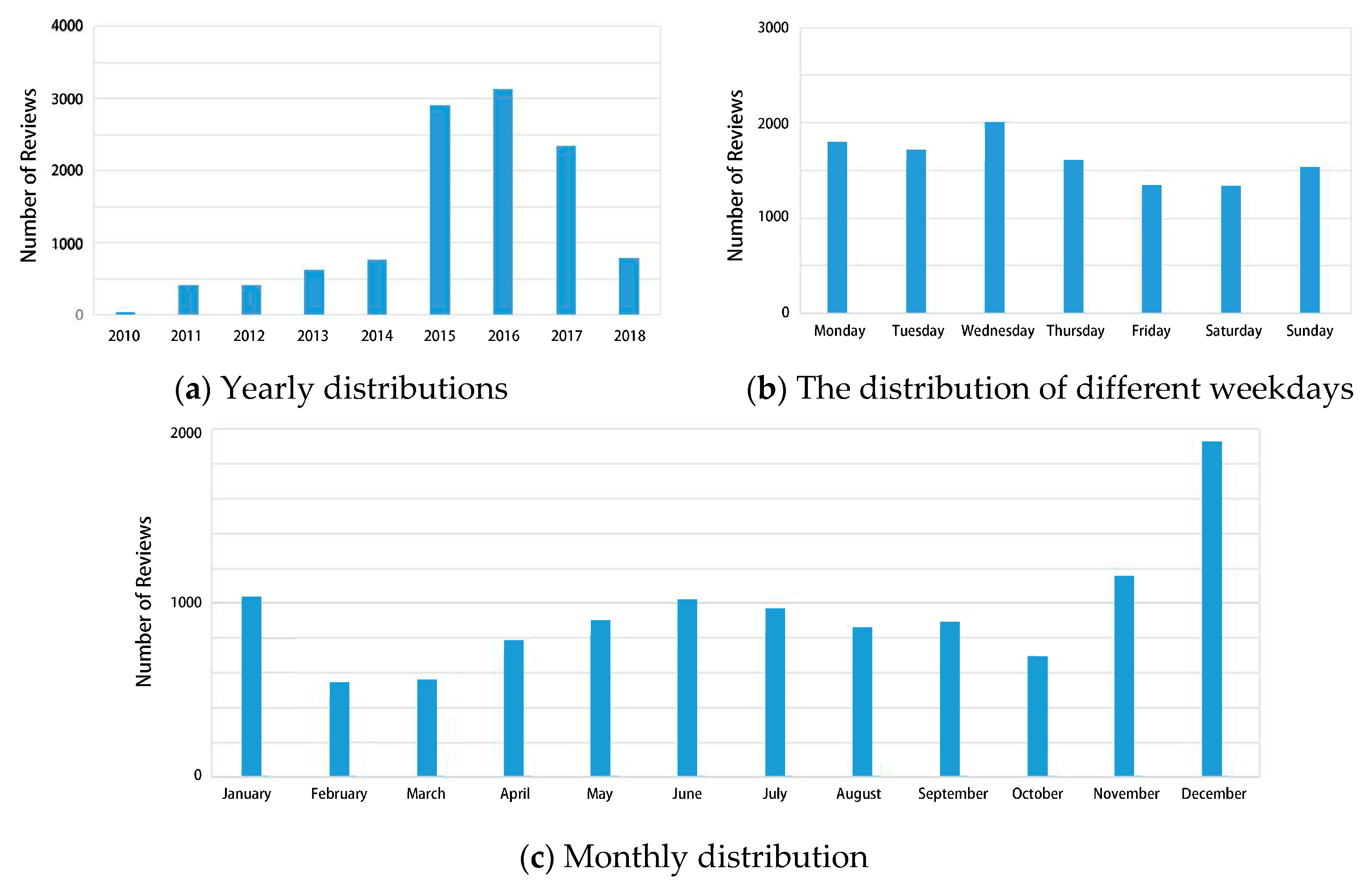
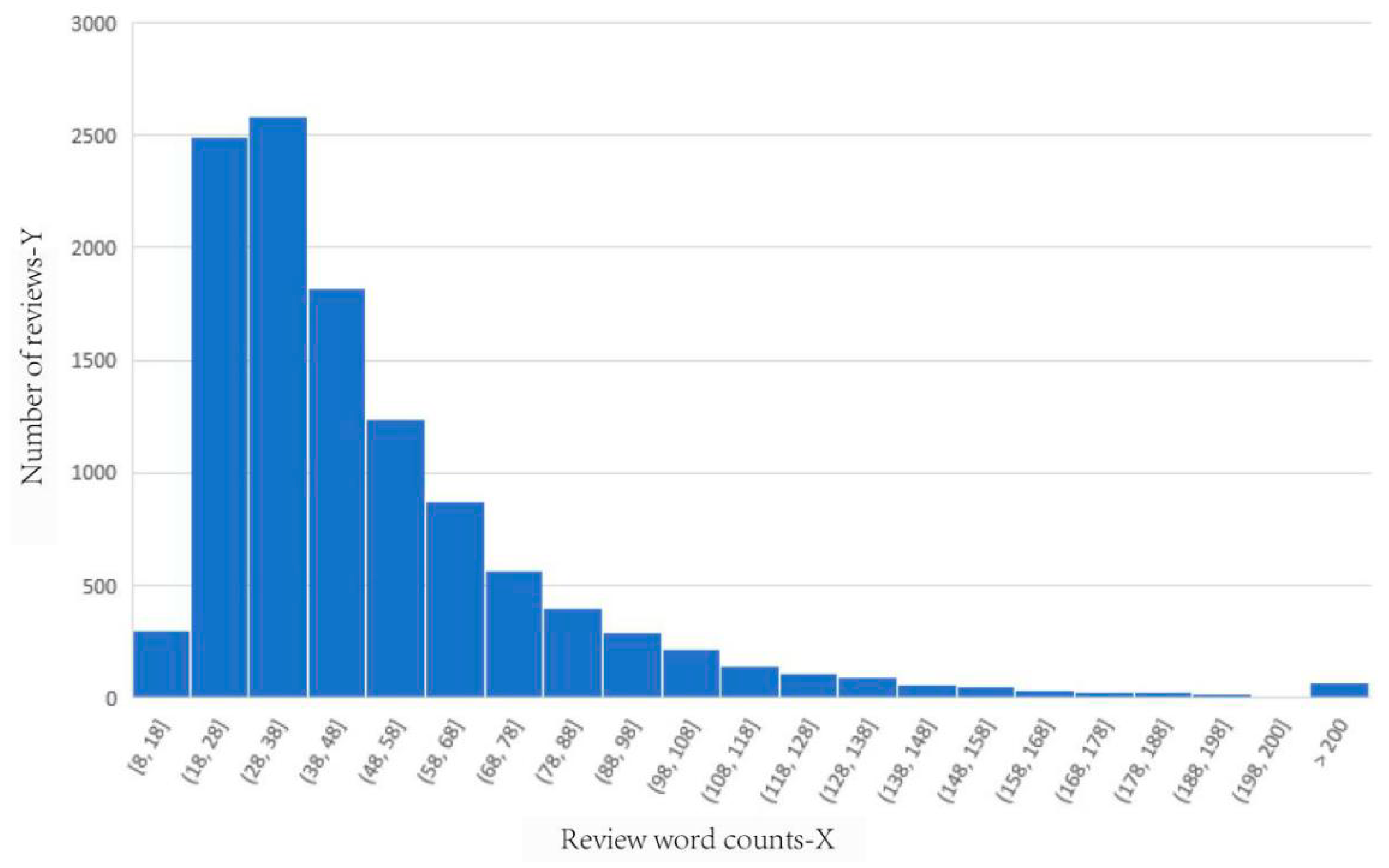
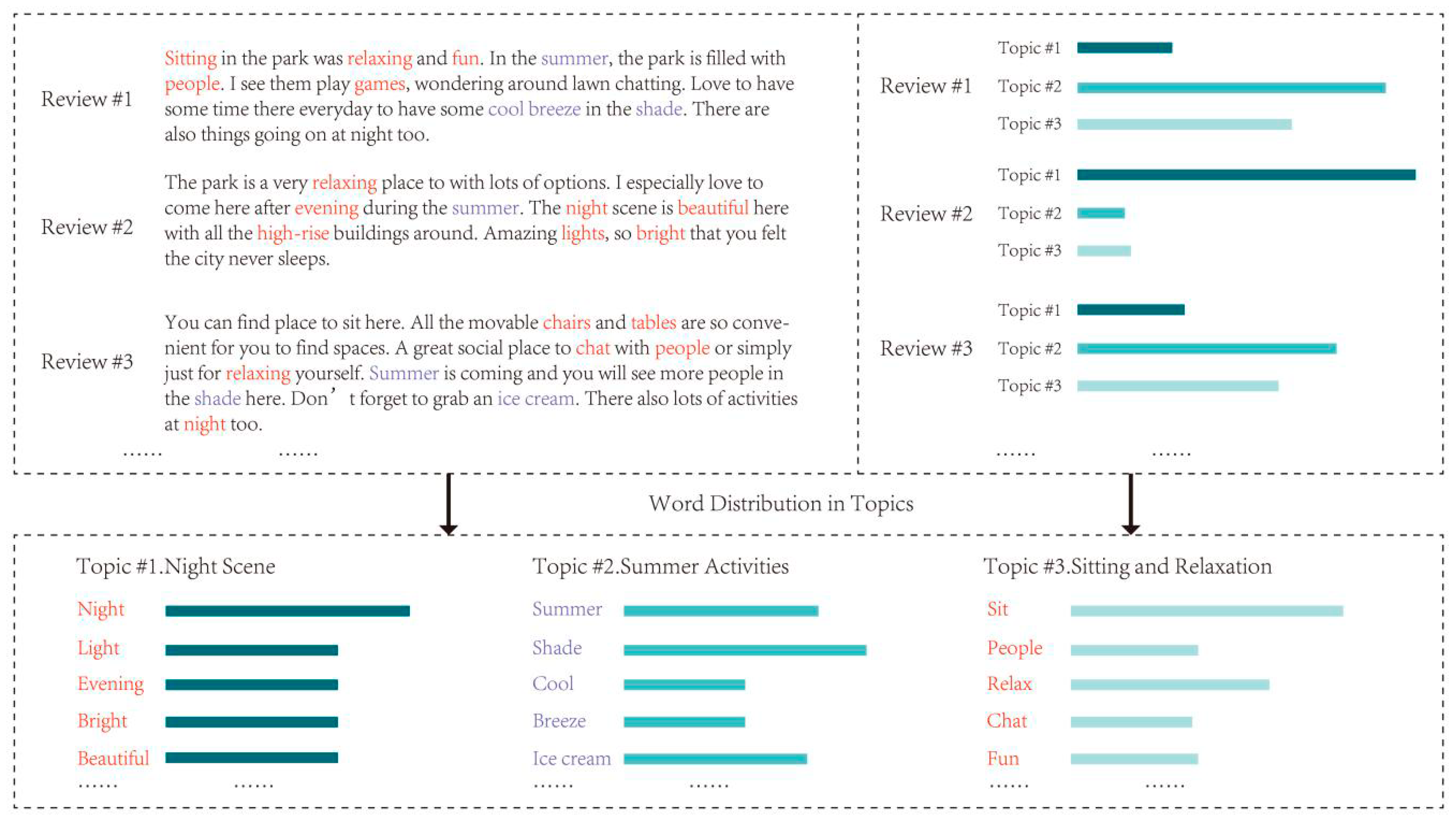
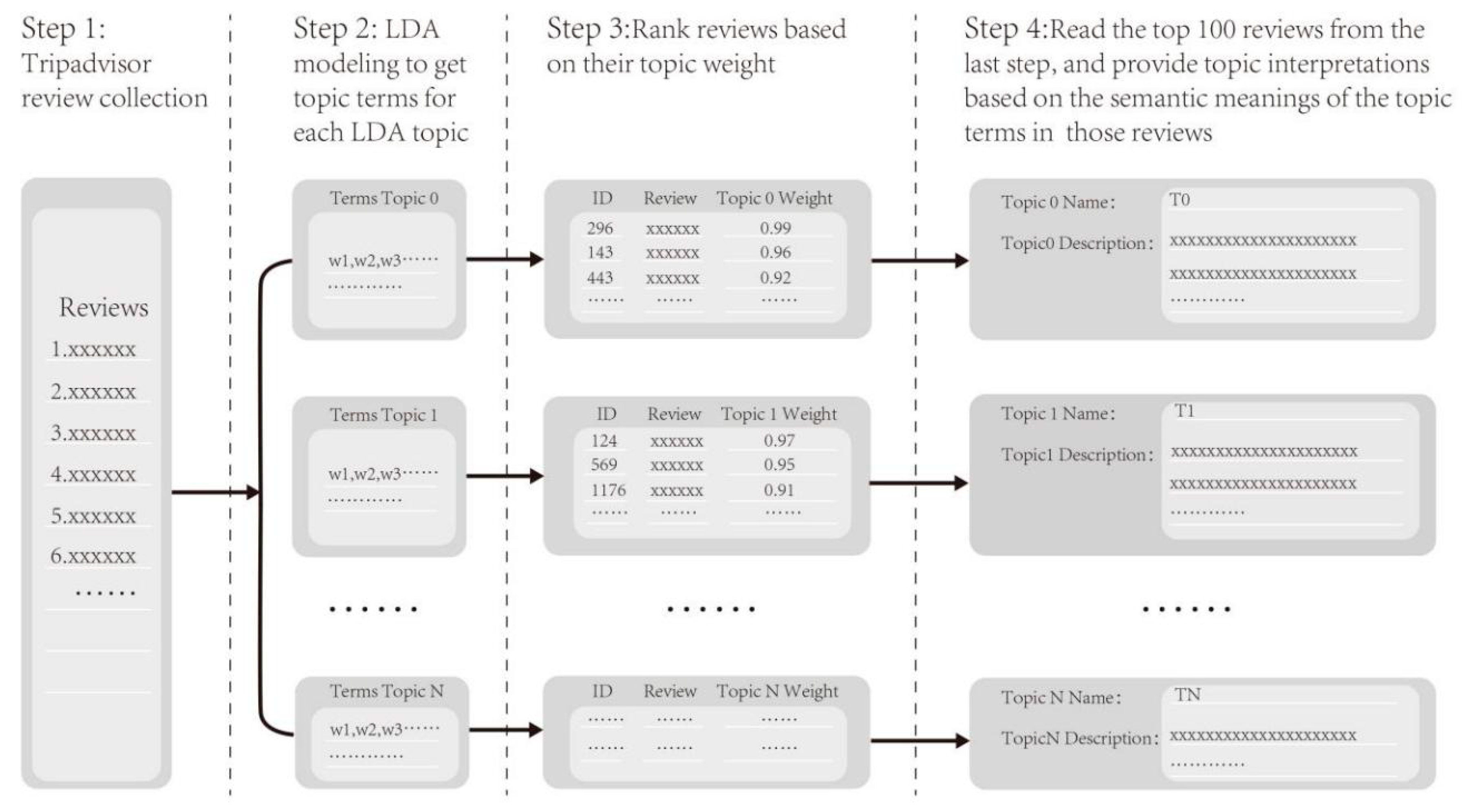


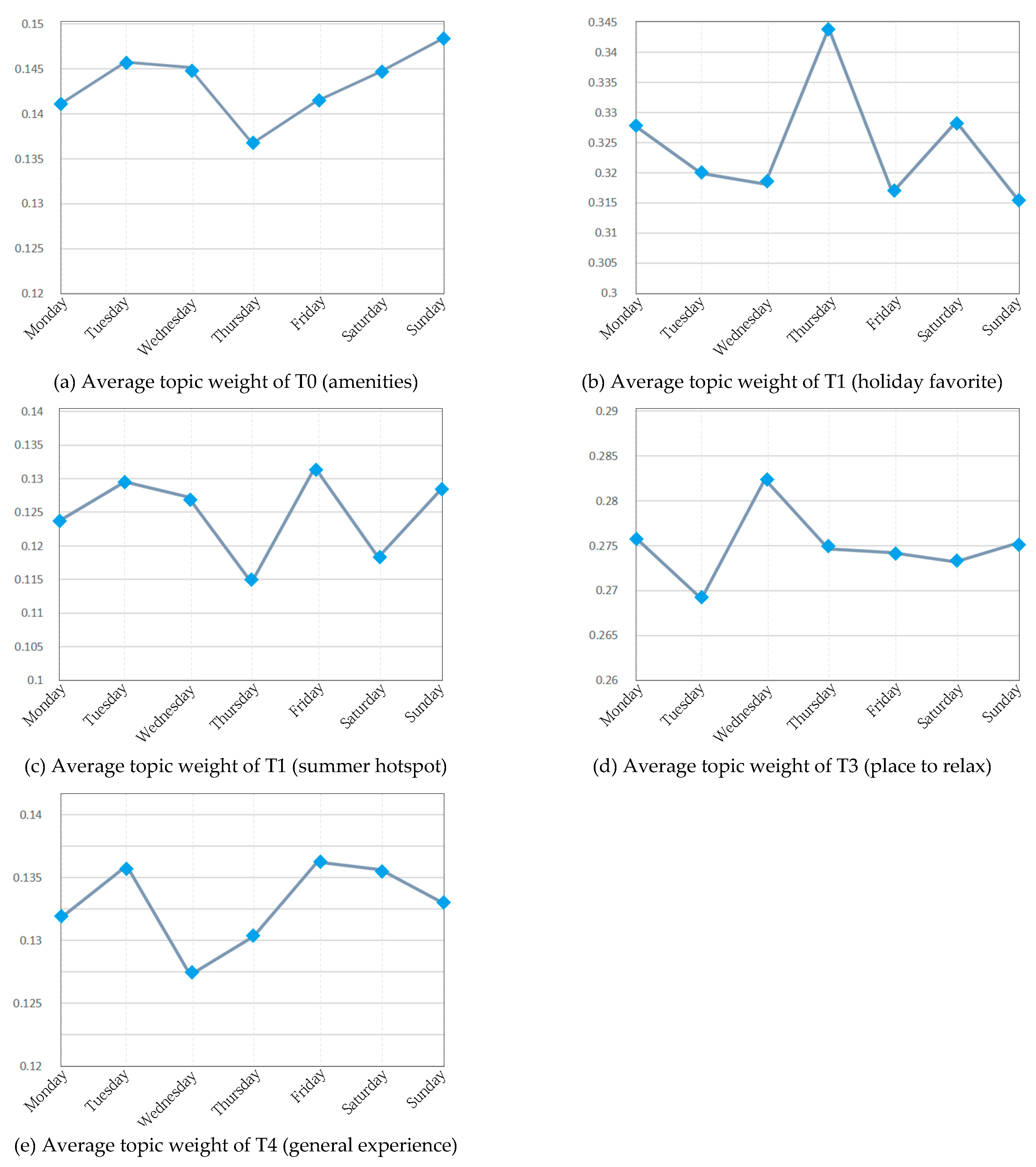
| Amenities (Topic 0)- | Holiday Favorite (Topic 1) | Summer Hotspot (Topic 2)- | Place to Relax (Topic 3)- | General Experience (Topic 4)- |
|---|---|---|---|---|
| 0.046 * “library” | 0.042 * “ice” | 0.021 * “summer” | 0.030 * “sit” | 0.022 * “day” |
| 0.032 * “public” | 0.036 * “skating” | 0.021 * “free” | 0.030 * “great” | 0.015 * “time” |
| 0.017 * “table” | 0.030 * “rink” | 0.021 * “movie” | 0.025 * “nice” | 0.014 * “would” |
| 0.013 * “area” | 0.030 * “Christmas” | 0.013 * “people” | 0.025 * “people” | 0.011 * “lovely” |
| 0.013 * “behind” | 0.022 * “shop” | 0.012 * “time” | 0.020 * “watch” | 0.010 * “went” |
| 0.012 * “beautiful” | 0.018 * “great” | 0.011 * “event” | 0.018 * “relax” | 0.010 * “really” |
| 0.011 * “carousel” | 0.016 * “winter” | 0.010 * “night” | 0.016 * “coffee” | 0.009 * “visit” |
| 0.011 * “chair” | 0.015 * “market” | 0.010 * “great” | 0.015 * “time” | 0.009 * “people” |
| 0.010 * “well” | 0.015 * “food” | 0.010 * “game” | 0.014 * “enjoy” | 0.009 * “night” |
| 0.010 * “right” | 0.014 * “time” | 0.009 * “show” | 0.013 * “lunch” | 0.009 * “visited” |
| 0.009 * “also” | 0.013 * “holiday” | 0.008 * “always” | 0.013 * “take” | 0.009 * “back” |
| 0.008 * “small” | 0.013 * “skate” | 0.008 * “activity” | 0.011 * “around” | 0.008 * “building” |
| 0.008 * “next” | 0.011 * “little” | 0.008 * “playing” | 0.011 * “food” | 0.008 * “loved” |
| 0.008 * “free” | 0.011 * “tree” | 0.008 * “nyc” | 0.011 * “little” | 0.008 * “around” |
| 0.008 * “book” | 0.010 * “stall” | 0.008 * “going” | 0.011 * “drink” | 0.008 * “enjoyed” |
| 0.007 * “reading” | 0.009 * “visit” | 0.007 * “chess” | 0.010 * “table” | 0.007 * “beautiful” |
| 0.007 * “game” | 0.009 * “fun” | 0.007 * “play” | 0.010 * “eat” | 0.007 * “walked” |
| 0.007 * “clean” | 0.009 * “nice” | 0.007 * “yoga” | 0.009 * “lovely” | 0.007 * “came” |
| 0.007 * “green” | 0.008 * “around” | 0.007 * “music” | 0.009 * “day” | 0.007 * “nice” |
| 0.007 * “lawn” | 0.007 * “vendor” | 0.007 * “concert” | 0.009 * “middle” | 0.007 * “little” |
| Topic Name | Description | Review Examples |
|---|---|---|
| Amenities (Topic 0) | This theme focuses on passive activity, relaxation, and the site features that enable and encourage people to take a seat and stay awhile. The theme characterizes the park as a place to take in the world- the sun, the people, the food, and the beautiful surroundings. People-watching and leisure are passive activities that occur here, and food often provides comfort and rejuvenation while doing so. | The park contains the New York public library, a restaurant, several street shops, board games, and a huge lawn area. |
| Plenty of seating, activities, eating options and a carousel that plays french music....ahh, very relaxing. | ||
| Take a visit to the public library then rest up among the trees of the park or stretch out in the lawn. | ||
| This park is beautiful, well kept, options for games and some recreational activities like table tennis, even free open WiFi. | ||
| Lovely small park next to the library in Manhattan. | ||
| Holiday Favorite (Topic 1) | The winter holiday season is featured in this theme with a focus on seasonal shops, specialty food vendors, and ice skating. The spirit of the holidays is enhanced by the seasonal décor, the tree, and the many programmed features such as the Winter Village. The site is a favorite among many holiday goers for its fun and lively atmosphere, despite the crowds. Food vendors sell a unique variety of treats, and shopping features novelty and crafted items appropriate for special gifts. | From the ice staking rink to the pub, to the Christmas decorations and huge tree-the whole atmosphere was terrific. |
| All the market stalls and artisans were so much fun to visit and talk to. I’m someone who is full of questions and loves to examine well-crafted items; the owners were all so patient and kind, and had loads of suggestions for me. | ||
| With over 140 shopping kiosks, food vendors, a carousal, ice skating rink and beautiful Christmas tree there is something for everyone | ||
| Summer Hotspot (Topic 2) | This topic centers on enjoyable summer activities and the vibrance of the park during the warm weather months. Site programming and events including movies, Broadway shows, outdoor movies, and yoga are highly recommended, as are the free games such as chess and ping pong. The park provides affordable and amusing activities throughout the season which encourage users to relax, people-watch, and to eat and drink. | It’s a gem! It has everything! Summer yoga classes, outdoor movie nights, chess, bingo, dance and music sessions! |
| Love, love this park! Been here before, and there’s food and every Friday night this summer there’s free play or entertainment. There was a Shakespeare play happening at this time. Chairs all set up and free! Very cool! Just a cool place to visit. | ||
| My family and I stopped at Bryant Park late Friday afternoon and to our delight there was a lot going on! Between the jazz concert, food, beer, games, miniature golf, chess and lots more, a stroll in the park turned out to be fun in the park. My favorite was the Jazz concert and the games. | ||
| Monday nights during the summer, pack a blanket, bottle of wine, repellent, and head out to Bryant park for classic movies. Movie begins at sunset with a Warner Bros cartoon as appetizer, which by itself can melt your heart. | ||
| Place to Relax (Topic 3) | This theme focuses on passive activity, relaxation, and the site features that enable and encourage people to take a seat and stay awhile. The theme characterizes the park as a place to take in the world- the sun, the people, the food, and the beautiful surroundings. People-watching and leisure are passive activities that occur here, and food often provides comfort and rejuvenation while doing so. | Great park in the city to hang out and relax after shopping or site seeing. Plenty of seats spread all around, great friendly atmosphere with food easily to obtain from surround outlets to eat in the park. Activities always going on to watch. A great few hours break. |
| In the heart of midtown Manhattan in the greatest city in the world, come feel the beat! An open air park, depending on the day, vendors, food and entertainment. I like the noon rush with workers pouring onto the streets and through the park. Bring the family for a short visit or people watch for hours. | ||
| A big beautiful park in the middle of Manhatten. Lots of places around to get food/drinks. Then lay down on the grass, enjoy the sun or all the people and just let time pass you by and recharge. | ||
| Right in the centre of midtown Manhattan is this beautiful garden, flanked by restaurants and bars and coffee shops. we sat in the sun and had a cold beer whilst watching the world go by. A nice spot to take a break in the city. | ||
| It’s a park ok, trees, grass, plants, places to eat and tables around. But. I love it. It’s not a place to hurry and take photos, it’s better to go with time, buy something to eat and drink (picnic perhaps) and stay for a while. Peaceful place in a crazy city. | ||
| General Experience (Topic 4) | This topic provides a general concept as a casual and typically pleasant experience. Many users in this category stumbled upon the park or strolled through it based on its convenient location. While some characterized the park as an ordinary typical urban park, it still serves as a respite from the hustle and bustle of the city and a place to visit again and again. The attractiveness of the park, good atmosphere, and buzzing ambiance both day and night add to this park’s appeal. Additionally, whether positive or negative, in this topic users compare the location to Central Park. | Bryant Park is quite a nice place to sit, enjoy the view and the sun. A very beautiful park to get to know in NY. There’s this restaurant (seems nice) inside the park, which seems a great option to spend some more time in this beautiful place. |
| This is a really lovely area. Lots of places to sit and watch the world go by. We had a nice meal in one of the restaurants. Lots and lots of seating and snack bars or you could buy food elsewhere and just grab a table. A nice place to chill. | ||
| It was a lovely day to hang out in the park and get a breath of fresh air. Bryant Park offers a nice setting with plenty seating to grab a bite, coffee or drinks and hang out with friends or just to relax or people watch. | ||
| I had a relaxing time walking around and sitting at Bryant Park. It’s centrally located so we did so after some shopping at Macys which was walking distance from there. There were some nice coffee shops across the road from the Park. Overall it was very pleasant and it was a sunny day too. | ||
| Lots of tables, lots of benches, lots of birds and lots of people. This is literally in the center of the city. A nice place to sit and relax after walking 5th Ave or visiting Times Square. |
© 2020 by the authors. Licensee MDPI, Basel, Switzerland. This article is an open access article distributed under the terms and conditions of the Creative Commons Attribution (CC BY) license (http://creativecommons.org/licenses/by/4.0/).
Share and Cite
Song, Y.; Fernandez, J.; Wang, T. Understanding Perceived Site Qualities and Experiences of Urban Public Spaces: A Case Study of Social Media Reviews in Bryant Park, New York City. Sustainability 2020, 12, 8036. https://doi.org/10.3390/su12198036
Song Y, Fernandez J, Wang T. Understanding Perceived Site Qualities and Experiences of Urban Public Spaces: A Case Study of Social Media Reviews in Bryant Park, New York City. Sustainability. 2020; 12(19):8036. https://doi.org/10.3390/su12198036
Chicago/Turabian StyleSong, Yang, Jessica Fernandez, and Tong Wang. 2020. "Understanding Perceived Site Qualities and Experiences of Urban Public Spaces: A Case Study of Social Media Reviews in Bryant Park, New York City" Sustainability 12, no. 19: 8036. https://doi.org/10.3390/su12198036
APA StyleSong, Y., Fernandez, J., & Wang, T. (2020). Understanding Perceived Site Qualities and Experiences of Urban Public Spaces: A Case Study of Social Media Reviews in Bryant Park, New York City. Sustainability, 12(19), 8036. https://doi.org/10.3390/su12198036







